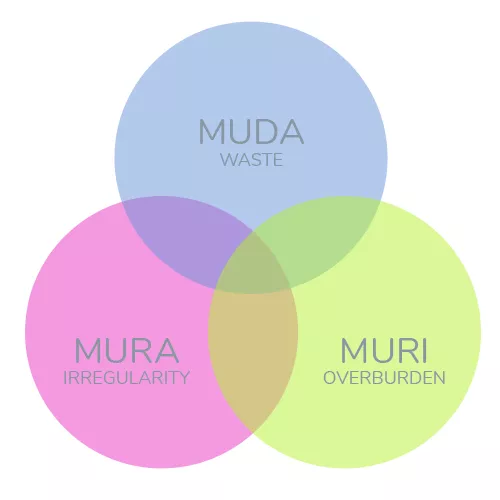
When the Lean methodology was born out of the Toyota Production System, back in the mid-20th century, a principal aim was waste reduction along production lines. A wasteful activity accounts for any event that does not add value to your business – resulting in a waste of either time, resources, or money. These wasteful activities became termed – Muda.
However, it was soon realised that the reduction of waste could have adverse knock-on effects on other aspects of the business’s efficiency, and it was not as simple as just looking to reduce these wasteful activities. The operational activities of a company are all interconnected; therefore, one action to reduce waste has the potential to have a detrimental effect elsewhere.
Muda, Mura and Muri
This is where the two other ‘M’s come into play – Mura (unevenness or inconsistency) and Muri (overburden or an unrealistic expectation).
Let us look into the Muda, Mura, and Muri in more detail – and how they all interconnect.

Muda
First, it’s a good idea to remind ourselves of the first two stages of lean. This is when you are defining value and mapping the value stream, and this is where Muda would be first introduced.
The first stage – defining value – is where you decide what value your product or service brings to your target customer (what are they willing to pay for it?).
The second stage – value stream mapping – is where you identify the processes and activities behind the product or service, and figure out whether each one adds value to the defined value (the figure you worked out previously). This is where you identify specific areas of Muda – the activities that do not bring value.
Muda 7 Wastes
Muda can be broken down into two categories:
1) non-value-added but necessary, i.e. safety testing
2) non-value and unnecessary
All types of waste that are categorised into the second type – must go! We are probably all acutely aware of what sorts of activities might end up here – but as a reminder – here are seven categories, as specified by the lean thinking methodology.
- Transport – this is the transportation of goods or products between locations. This should always be minimised as this will never bring any value to the customer.
- Inventory – this can lead to a waste of storage space for useful products and other indirect issues such as money spent on wasted energy bills!
- Motion – could the action of an employee or a machine be minimised? Machines are prone to more wear and tear if overused, and employees’ extra movements can add time to processes. This could be something as small as having to lean over and pick up an object!
- Waiting – this is when the production line is halted by one task– and causes a chain reaction where all subsequent tasks are affected. Employees and machines are therefore not able to operate to full capacity.
- Over-processing – these are pointless operations that do not add any value. It’s essentially processing for the sake of it! For example, unnecessary plastic packaging or painting an area that won’t be seen.
- Overproduction – this is the stocking up of material that goes unused, leading to it being thrown away or taking space in the inventory.
- Defects – when the product doesn’t meet the standards required, this means a replacement, extra paperwork and potential customer loss.
Mura
Mura means irregularity. In other words, this is when processes are inconsistent, and as a result, this leads to the wasteful activities we found with Muda!
So how does this happen? If your process isn’t smooth, it means that unfair, unreasonable and unnecessary pressure is put on the separate stages of the production line. You need flow!
One example of this is when managers are given a monthly target. If they are a week off their final target date, they may try to rush through production and processes. This can cause more mistakes (defects), and use up of parts, leading to a shortage further down the line.
It is so important to ensure that all parts of the process are on an equal playing field so Mura doesn’t lead to Muda. Just in Time is a good pull-based system adopted by many companies, which helps to reduce overproduction and an inventory of useless items.
Muri
Muri can be the direct result of Mura, but also from the removal of Muda too. It is the overburden that can be put on employees and machines that may be expected to work at more than 100% capacity. This is unsustainable, and long-term can have devastating effects on employees’ health and well-being, and machines pack up far earlier than expected. Standardising work process and procedures and evenly distributing a workload can help to relieve Muri to ensure no employee or machine is overburdened.
It is important to remember that the Lean Methodology is about creating a culture – looking after your employee’s health is of utmost importance, to ensure that a positive working environment is created.
How to Eliminate Muda, Muri and Mura
So how do we go about eliminating the 3 Ms? With now so much more to think about – you’d think it could become quite complicated. You’re wrong – as long as you have a good plan nothing is complicated!
That’s where the 5 ‘S’ system comes in. Originally developed as a Lean Methodology tool, it can be applied to almost any business.
- First, you sort, removing any equipment or tools in the workplace that are useless. This decluttering will free up space, that can now be used for something that adds value. Tidy work = a tidy mind!
- Next is when you set in order. This is when you organise the workflow most efficiently based on how work is conducted.
- The third step is shine. Like you would spring clean your house, you need to ensure that everything and everyone is in tip-top condition. Machines should be cleaned and maintained – this will make it easier for you to spot defects. Whilst with employees, see that they have the adequate training and resources to fulfil their role.
- Next, you will want to standardise your tasks. This will mean the creation of rules, guidelines, standard operating procedures (SOP), to ensure consistency across the production and work line.
The final, and ongoing stage of the 5 ‘S’ system is the sustain stage. This is to ensure that this system is a daily habit of all employees.
3M / Three Ms – Muda, Muri and Mura
Muda, Muri and Mura (3M or Three Ms) are all interrelated in some way. Neither one can be ignored – even despite the results of Muda waste reduction being much more obvious and noticeable.
Each plays a part, and to ensure the lean methodology is adhered to across the organisation, it is important that all three are considered. Although we often mainly focus on the removal of Muda, perhaps if we focused more on Muri and Mura, we would naturally see a fall in Muda… Just something to think about!
Eliminate the three Ms to become more efficient, and productive and save time and money!